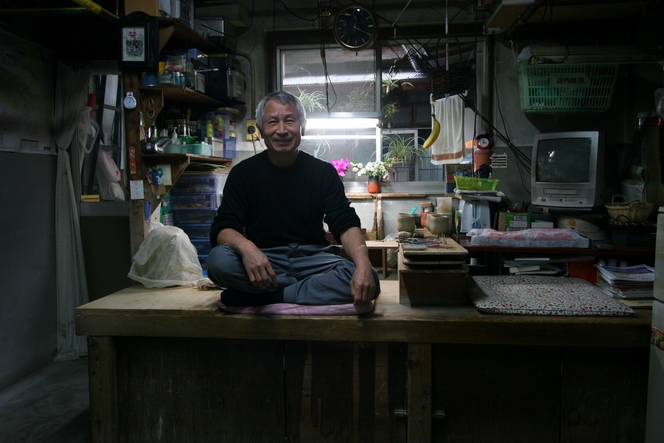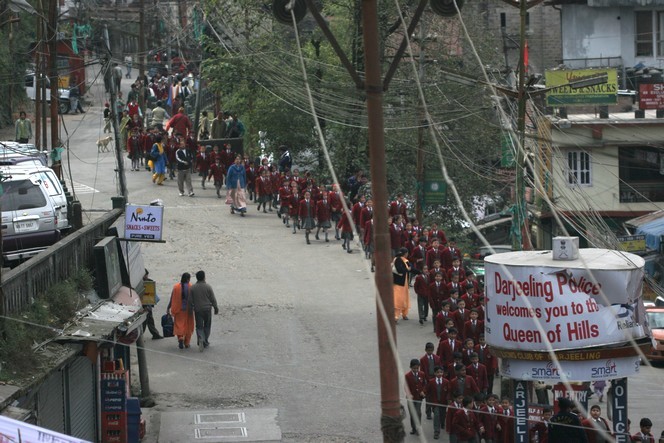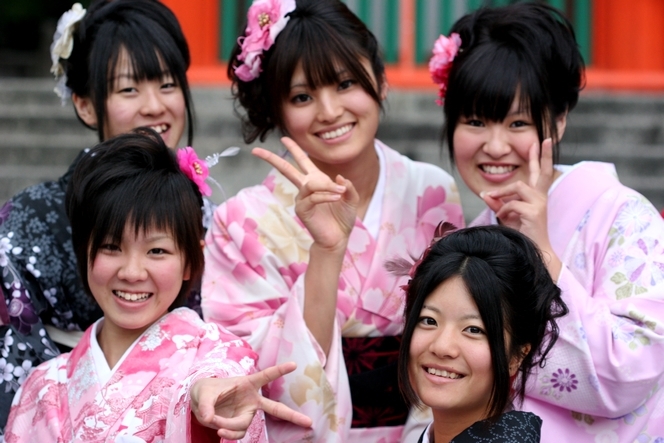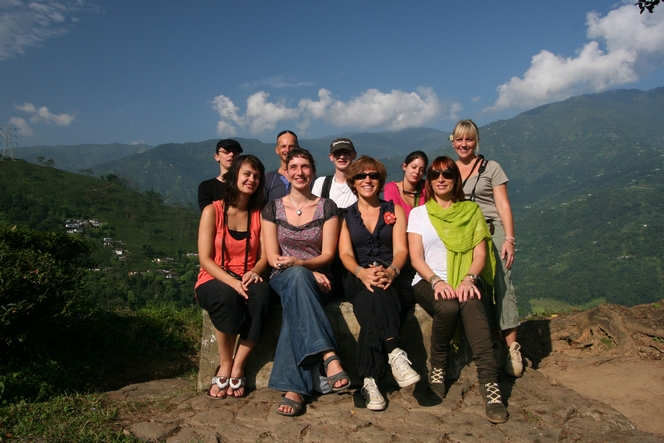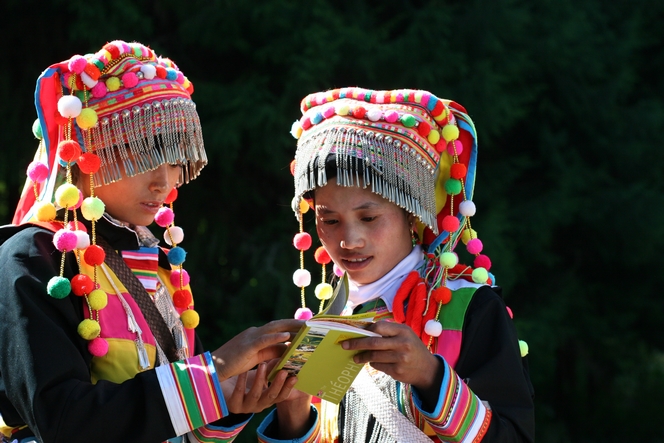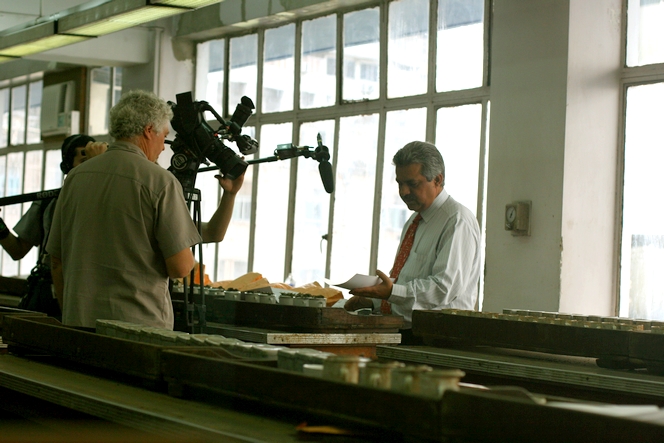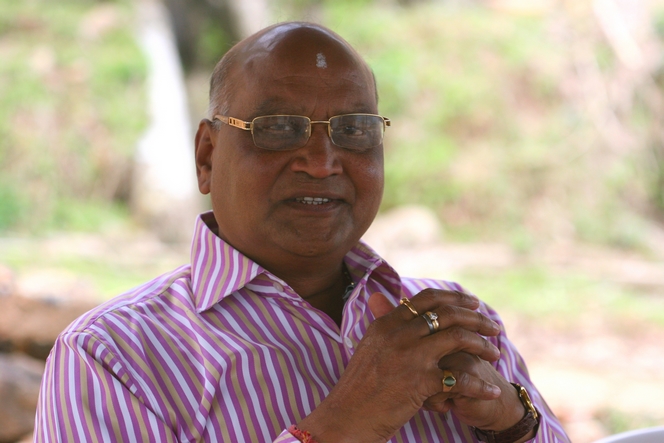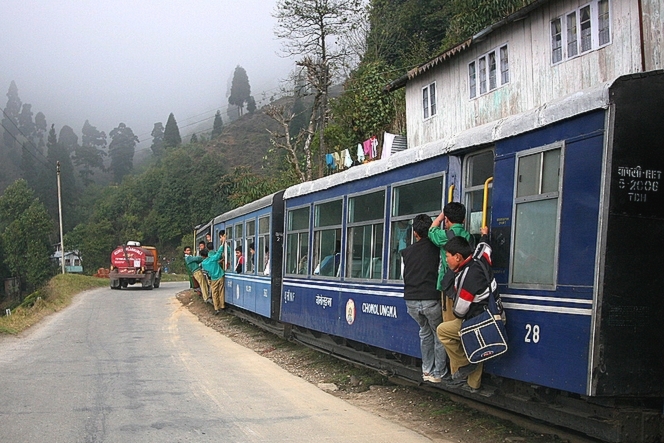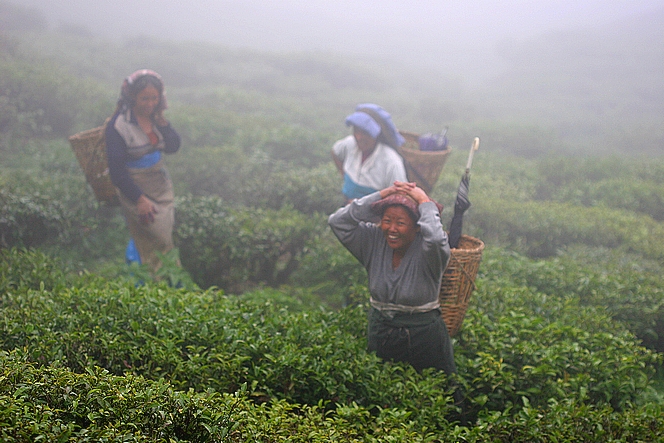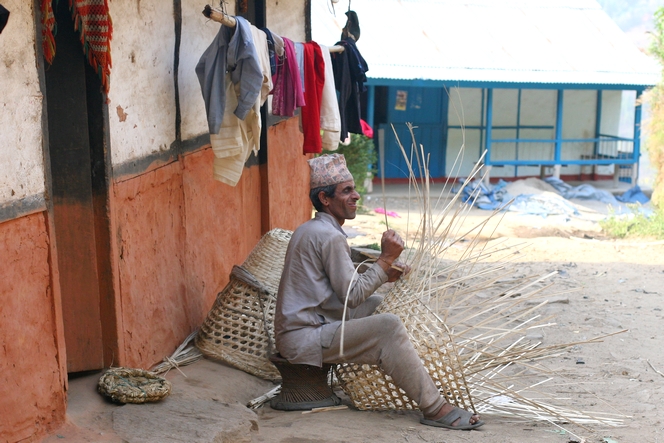In my previous post I spoke of the master potter Hattori Koji-San. I showed you his agile hands at work. Here he is in his studio in the centre of Kyoto. For the photo, he decided to sit where he would normally place his wheel. This year, Le Palais des Thés has asked Hattori Koji-San to make its raku bowls. The various colours are achieved by the use of different mineral pigments. Part of the craftsman’s skill is to achieve the desired crackled finish to the glaze, along with the black, red or white tones that can symbolise stars or seasons, snow or night.
Tea people
School children in uniform on Nehru Road
In Darjeeling, like everywhere else in India, school uniform is taken seriously. At every level of the education system, school colours are worn with pride. Here, the boys and girls are wearing the school crest embroidered on their blazers, and perfectly knotted ties. I imagine one of the benefits of this system is to iron out differences in social backgrounds.
This morning parade gives me the opportunity to show you a street in Darjeeling. This is Nehru Road, where my hotel is. Look at the complex networks of electrical cables. They inspire respect for the engineers, who must have a very difficult job with repairs.
You will also notice that in this city, affectionately known as the “Queen of the Mountains”, the Darjeeling police, despite the battered air of their station, extend a warm welcome to visitors!
A happy year
Kyoto is undoubtedly a traditional city, but that does not exclude a certain sense of fun. I have chosen these happy Japanese women, who must sometimes wear less classic outfits than these, to be my ambassadresses in wishing you a wonderful year in 2011, a year in which we might allow ourselves to express our “joie de vivre” in front of a passing photographer, a year in which we might take the time to observe such delicate things as the petals of cherry blossom.
Le Palais des Thés on a trip to Darjeeling
As promised, here’s a picture of the team who accompanied me to Darjeeling last month. From left to right: Yann (Rue du Cherche-Midi store, Paris), Stéphanie (Grenoble store), myself, Virginie (Brussels store), Thomas (warehouse), Carine (Ecole du Thé), Maud (Rue Vieille-du-Temple store, Paris), Fabienne (Lille store) and Nathalie (human resources).
We spent a week in Darjeeling, where this great team were able to discover the region I love, meet our suppliers, and put every question imaginable to the tea plantation managers. And meet the people who toil to produce such rare teas. We had some wonderful encounters, and the trip further deepened my understanding of this field, which I have always found so rewarding.
The Lisus climb giant tea plants
Many ethnic groups live alongside one another in the province of Yunnan (China). The Hans are there of course, as is the case across China, but at least 20 minority groups live there too, including the Dais, Miaos, Nus, Huis, Was and Yis. Here, on the border between China and Myanmar (Burma), we are with the Lisus.
These people live from farming in the remote mountainous regions. They also grow tea, or rather, they harvest the leaves that grow on giant tea plants. It is an incredible sight to see them in their traditional costumes climbing to the tops of trees 10 or 20 metres high, wicker baskets on their backs, working away. It makes you hold your breath.
Here, I have caught two Lisus women closely examining the Théophile Guide. They are looking at the list of stores on the back cover with quite serious expressions that contrast with the strings of brightly coloured fluffy balls that swing gently on either side of their faces.
This Sunday at 2.45pm on France 5: “Tea for all”!
There are not many documentaries on tea, so when one comes up on television we shouldn’t miss it. As part of its Global Drinks series, France 5 is showing a documentary called “Thé pour tous” (Tea for all), this Sunday at 2.45pm. The report lasts 52 minutes, which is quite exceptional. The director Stefano Tealdi travelled through various countries including Japan, Taiwan, the UK and India, and also stopped in Paris. We met a year ago and I agreed to him accompanying me into the tea mountains. So in February, we met in Kolkata. We then took the Darjeeling route in the company of Sandro DeFrino, his camera man, and Angelo Galeano, his sound recordist.
It is not easy to travel with a TV crew in places you love, on the other side of the world. It’s a bit like being with a bull in a china shop. But with Stefano, Angelo and Sandro it was real pleasure; all of them treated everyone we met with great respect, and they showed a deep understanding of the nuances of local identities. It’s a rare thing. I was very pleased to have met them. I think we started to develop a friendship and I’m looking forward to seeing their film.
In this photo, taken in Kolkata, Stefano Tealdi, with his back to the camera, is talking to Krishan Katyal, director of the tea auctioneers J Thomas & Co. Krisham is one of the leading experts in India, and I’m sure I’ll be telling you more about him another time.
Ps: for the people who, like me, do not have the television, you can clic here http://documentaires.france5.fr/documentaires/global-drinks/pour-tous to view the programme until October 24th
Gopal Somani: an experienced grower in Darjeeling
Tomorrow I am going to visit my friend Gopal Somani. Gopal is one of the most important people in Darjeeling. He is one of the two or three most experienced growers, and his teas win the most prestigious awards. He supervises the plantations of Puttabong and North Tukvar, a vast area with altitudes that vary by more than 1 000 meters and which, in season, produces truly exceptional teas. With his high standards and attention to detail, this expert has taught and trained many Darjeeling growers over the past two decades. I myself have learnt a huge amount from him.
Tomorrow we are going to tour the North Tukvar plantation together, and taste his recent teas. Then I am invited to lunch at his bungalow. And if I mistakenly use my fork to eat instead of my right hand alone, as is customary in India, he will make his habitual remark: “Why are you using your false hand to eat when the gods gave you a real one!”
On the way to school in Kurseong
Almost the beginning of the new school year ! In Kurseong (India), these schoolboys jump on the Toy Train’s bandwagon and hold on the outside, not because the train is packed, but simply because it’s actually more fun doing the journey with the head in the breeze.
They laugh, say hello to the people they know when the train crosses a village: a pleasant way to get to school.
Tea pluckers in the mist of Badamtam
In the middle of summer, a bit of freshness is always welcome. Like this refreshing mist coming from the foothills of the Himalayas. People there are so used to living in the clouds that this humidity is part of their life and no-one pays any attention to it. It’s actually not unpleasant, just look at the faces of these tea pluckers and you’ll see that no-one seems depressed by it. They look like they’re having fun, in fact.
This is at Badamtam, a magnificent plantation located in the north of Darjeeling, across from Sikkim.
Just a detail: do you see the umbrella in the basket? Well, it is actually used when the sun comes out, to provide shade and keep a nice complexion.
Basket made for harvesting tea
Plucking tea, practically leaf by leaf, is a major undertaking. In some countries, pickers carry baskets on their backs to hold the leaves. These baskets have an open weave to allow the air to circulate inside and prevent the leaves from fermenting, which would spoil the pickers’ hard work.
There are several clues to the fact that I took this photo in Nepal: the man’s attire, particularly his hat, which is the kind worn by many Nepalese; the house with its ochre finish halfway up the mud walls, and the white sections picked out by the darker lines; lastly, for those who’ve spent time on the tea plantations, the shape of the basket itself, which becomes square as it widens at the top, and exists only in this region.
This scene took place near Phidim, in the far north of Ilam Valley, in the easternmost part of Nepal (Kanchenjunga Tea Estate is nearby; the Nepal Green Tea Factory and the Himalayan Shangri-La Tea Factory are a little further away).
Nepal remains a largely rural country. Here, two hours’ walk from the nearest village, people obviously need to do everything for themselves. They weave in front of their homes, without becoming distracted by the stranger taking photos of them.

